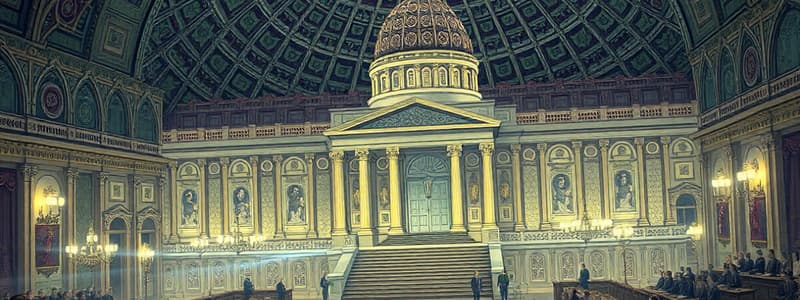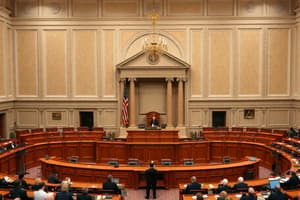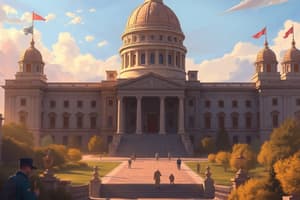Podcast
Questions and Answers
How does the structure of Congress balance power between states with large and small populations?
How does the structure of Congress balance power between states with large and small populations?
- By giving each state representation based on its geographic size.
- By allocating committee assignments based on state population.
- By establishing a bicameral legislature with the House based on population and the Senate with equal representation per state. (correct)
- By allowing states to directly elect the President through the Electoral College.
What is the primary focus of Members of Congress (MOCs) according to Mayhew's 'electoral connection'?
What is the primary focus of Members of Congress (MOCs) according to Mayhew's 'electoral connection'?
- Overseeing bureaucratic agencies.
- Reelection through advertising, credit claiming, and position-taking. (correct)
- Promoting long-term controversial reforms.
- Crafting effective policy and legislation.
Which of the following is a key difference between the House of Representatives and the Senate?
Which of the following is a key difference between the House of Representatives and the Senate?
- The House confirms executive appointments, while the Senate introduces all tax bills.
- The House has stricter rules and is more centralized, while the Senate allows filibusters and confirms appointments. (correct)
- The House declares war, while the Senate regulates commerce.
- The House has 6-year terms, while the Senate has 2-year terms.
What is the function of congressional committees?
What is the function of congressional committees?
How has the expansion of presidential power historically occurred?
How has the expansion of presidential power historically occurred?
Which of the following best describes the role of the Vice President?
Which of the following best describes the role of the Vice President?
What is the 'necessary and proper' clause and how does it affect Congress?
What is the 'necessary and proper' clause and how does it affect Congress?
What is the role of the Executive Office of the President?
What is the role of the Executive Office of the President?
Which of the following describes the function of the bureaucracy?
Which of the following describes the function of the bureaucracy?
What is 'agency loss' in the context of the bureaucracy?
What is 'agency loss' in the context of the bureaucracy?
What is the principal-agent problem as it relates to the bureaucracy?
What is the principal-agent problem as it relates to the bureaucracy?
What is the role of 'police patrols' and 'fire alarms' in congressional oversight of the bureaucracy?
What is the role of 'police patrols' and 'fire alarms' in congressional oversight of the bureaucracy?
What is one way bureaucrats can act as political actors?
What is one way bureaucrats can act as political actors?
What is judicial review, and in which court case was it established?
What is judicial review, and in which court case was it established?
Which of the following describes the structure of the federal court system?
Which of the following describes the structure of the federal court system?
What is the difference between a majority opinion, a concurring opinion, and a dissenting opinion in Supreme Court decisions?
What is the difference between a majority opinion, a concurring opinion, and a dissenting opinion in Supreme Court decisions?
According to Rosenberg's 'Constrained Court' view, what is required for courts to create real social change?
According to Rosenberg's 'Constrained Court' view, what is required for courts to create real social change?
What are the formal requirements to become the U.S. president?
What are the formal requirements to become the U.S. president?
Which of the following is an enumerated power of Congress?
Which of the following is an enumerated power of Congress?
What was the impact of Shelby v. Holder on voting rights?
What was the impact of Shelby v. Holder on voting rights?
Flashcards
Structure of Congress
Structure of Congress
Congress is bicameral, consisting of the House (based on population) and Senate (two per state).
Congressional Term Lengths
Congressional Term Lengths
House members serve 2-year terms; Senators serve 6-year terms. No constitutional term limits exist.
Role of Congressional Committees
Role of Congressional Committees
Committees manage legislation, control debate (House Rules Committee), and allow members to specialize in certain areas.
How a Bill Becomes Law
How a Bill Becomes Law
Signup and view all the flashcards
Enumerated Powers of Congress
Enumerated Powers of Congress
Signup and view all the flashcards
War and Appointments
War and Appointments
Signup and view all the flashcards
The Electoral Connection
The Electoral Connection
Signup and view all the flashcards
Incumbent Advantage
Incumbent Advantage
Signup and view all the flashcards
Gerrymandering
Gerrymandering
Signup and view all the flashcards
Presidential Requirements
Presidential Requirements
Signup and view all the flashcards
Presidential Powers
Presidential Powers
Signup and view all the flashcards
Inherent Presidential Powers
Inherent Presidential Powers
Signup and view all the flashcards
Executive Office
Executive Office
Signup and view all the flashcards
Chief Legislator Role
Chief Legislator Role
Signup and view all the flashcards
Commander-in-Chief
Commander-in-Chief
Signup and view all the flashcards
Purpose of the Bureaucracy
Purpose of the Bureaucracy
Signup and view all the flashcards
Principal-Agent Problem
Principal-Agent Problem
Signup and view all the flashcards
Judicial Power
Judicial Power
Signup and view all the flashcards
Supreme Court Decisions
Supreme Court Decisions
Signup and view all the flashcards
Study Notes
Congress and Representation
- Congress is bicameral, featuring the House (based on population) and the Senate (two senators per state).
- This structure balances the power between large and small states.
- House members serve 2-year terms, while Senators serve 6-year terms
- There are no constitutional term limits for either chamber.
- The House is designed to be more responsive to public opinion, while the Senate is more stable.
- The House has stricter rules and is more centralized compared to the Senate.
- The Senate allows filibusters and confirms presidential appointments.
- The 17th Amendment established the direct election of Senators.
- Committees (standing, select, and joint) play a crucial role in managing legislation.
- The House Rules Committee controls the debate process.
- Committees enable members to specialize in specific issues and develop expertise.
- Bills can originate in either the House or Senate, except for tax bills, which must start in the House.
- Bills go through committee, debate, and approval in both chambers before reaching the president.
- Most bills do not make it through the entire process and "die in committee".
- Congress's enumerated powers are listed in Article I, Section 8 of the Constitution and include the power to tax, regulate commerce, and declare war.
- The "necessary and proper" clause expands Congress's powers beyond those explicitly listed.
- Congress declares war, while the Senate confirms top executive and judicial appointments.
- Members of Congress are elected separately from the president, typically by plurality vote.
- This differs from parliamentary systems where voters choose a party rather than individual lawmakers.
- House districts have grown from 33,000 people in 1790 to over 700,000 today.
- The House has been capped at 435 members since 1911 due to space and efficiency concerns.
- Members of Congress (MOCs) are primarily motivated by reelection, focusing on advertising, credit claiming, and position-taking.
- This emphasis on reelection can lead to delay, narrow interests, and symbolic actions, potentially hindering long-term or controversial reforms.
- Incumbents have a significant advantage due to name recognition, fundraising capabilities, and favorable district demographics.
- Despite this advantage, Congress is often viewed poorly by the public.
- Congress is overwhelmingly composed of white, male, older, and wealthy individuals.
- Women and people of color are underrepresented in Congress.
- Congress's performance is often judged more on constituent services than on lawmaking.
- The public often perceives Congress as inefficient or corrupt.
- Gerrymandering, where states draw House districts for political advantage, is a contentious issue.
- Racial gerrymandering is illegal, but partisan gerrymandering is not fully banned.
- The Shelby v. Holder Supreme Court decision struck down part of the Voting Rights Act, ending the federal preclearance requirement for some states and leading to new voting restrictions.
- Court's often defer to states unless racial intent is proven for gerrymandering
The Presidency
- Presidents have typically been white, male, and Protestant, with political or military backgrounds.
- Obama, JFK, and Biden are exceptions to these norms.
- Formal requirements for president include being at least 35 years old, a natural-born citizen, and having lived in the U.S. for 14 years.
- Informal requirements include political experience and public appeal.
- Presidents are elected through the Electoral College, where a winner-take-all system in most states means some votes matter more than others.
- The 25th Amendment addresses presidential succession and disability.
- The Vice President takes over if the president is disabled or removed from office.
- The House has the power to impeach, while the Senate holds the trial.
- The President has diplomatic powers including treaties (with Senate approval), and appointing/receiving ambassadors.
- The President has legislative powers to propose laws and veto legislation.
- The President has administrative powers to enforce laws and appoint officials.
- The President has judicial powers to pardon and nominate judges.
- Inherent powers are not explicitly written in the Constitution but have been used by presidents during crises (e.g., Lincoln, FDR, Bush).
- The president's power has expanded through wars, emergencies, and economic crises.
- Modern presidents have large staffs and significant influence over national policy.
- The Vice President breaks Senate ties and steps in when needed.
- Cabinet secretaries lead departments and advise the president.
- The Executive Office includes the NSC (security), OMB (budget), and CEA (economics) to assist with coordination and policymaking.
- The First Lady is not elected but is often influential.
- The Chief Legislator sets the national agenda, lobbies Congress, and vetoes bills.
- The Chief Legislator cannot make laws directly but has significant influence.
- The President leads their party but cannot fully control it.
- Public approval provides political leverage, with high approval facilitating law passage and low approval weakening influence.
- The President is the Commander-in-Chief of the military.
- The War Powers Act attempts to limit this power, but presidents often bypass it.
- Presidents act quickly in crises, temporarily boosting approval.
- Presidents must work with Congress for long-term solutions.
The Bureaucracy
- The bureaucracy's purpose is to implement laws, enforce regulations, and manage services.
- Types of agencies include Cabinet Departments (e.g., State, Defense), Independent Agencies (e.g., NASA), Regulatory Commissions (e.g., SEC, FDA), and Government Corporations (e.g., USPS).
- The bureaucracy has expanded during wars, economic crises, and civil rights eras.
- More roles result in more agencies.
- The principal-agent problem arises because elected officials (principals) rely on bureaucrats (agents) who may have different goals.
- Agency loss occurs when bureaucrats are lazy, uncooperative, or pursue their own agenda.
- Oversight mechanisms include police patrols (regular checks and reports), fire alarms (public or interest groups reporting problems), appointments, budgets, and hearings.
- Some agencies develop alliances with interest groups or Congress, increasing their independence.
- EPA scientists pushing environmental policy despite political pressure exemplifies this.
The Courts
- The courts have judicial power to interpret laws and overturn laws or executive actions if unconstitutional.
- Judicial review was established in Marbury v. Madison.
- Sources of law include constitutional law, statutory law (laws passed by Congress), administrative law (agency rules), and case law (judicial rulings).
- The court structure includes District Courts, Circuit Courts, and the Supreme Court.
- State and federal systems operate separately.
- The Supreme Court selects the most important or conflicting cases.
- Supreme Court decisions include a majority opinion (binding), concurring opinion (agrees but for different reasons), and dissenting opinion (disagrees with the majority).
- The courts are limited because they depend on others to enforce decisions and lack budget or military power.
- Courts alone rarely create social change.
- Real reform requires support from other branches and public pressure (e.g., Brown v. Board led to slow change).
- Even when courts don't bring immediate change, legal battles can educate the public and build social movements.
- The Supreme Court has historically been mostly white and male.
- Descriptive representation (e.g., Justice Sotomayor, Justice Jackson) is slowly improving.
Studying That Suits You
Use AI to generate personalized quizzes and flashcards to suit your learning preferences.



